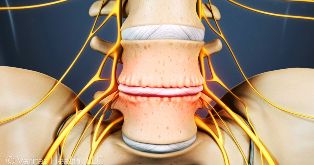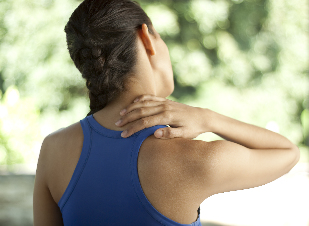In the modern world has this disease and almost all people of age at least 25 years. Other sections of the spine cervical osteokondrozis that are seen more often. Relevance of this topic cannot be overestimated.
In this paper, is the result of the cause, the disease presents itself similar to how a drug treatment cervical medicine which is effective, which is osteokondrozis etc etc .. other than there are methods and learn at the same time give answers to the most common questions with patients similar to.
Osteochondritis whiplash – this is a degenerative-degenerative defeat (progressive) intervertebral discs of the cervical spine. Therefore, how these changes are themselves intervertebral discs spine and joints and cervical.

Causes degenerative disc disease cervical
As a result of the action listed below that are caused by factors increasing the burden of the cervical spine, the neck muscles are trying to compensate for the overload is the result of them spasm, blood circulation in this region, resulting in degenerative changes. The changes that occur due to various factors, intervertebral discs, cervical, structure changes, breaks, joints, bone growth between the vertebrae visible small changes in their diet tel vertebrae, intervertebral discs increased the load changed.
Contributing factors, development, and degenerative disc disease of the cervical spine:
- The presence of incorrect posture and scoliosis
- Overweight
- Lack of exercise , a sedentary job
- Previous trauma, spine
- Metabolic
- A great physical load
- Constant stress and strain
- Low-level physical fitness
- Hereditary predisposition
- Habitual wrong body posture, for example, to hold the telephone handset shoulder
- Continuous tension, back, neck work, so the way (a very stressful situation for a sitting position) drivers, office workers.
- Cervical spine anomalies
The degree of development of cervical degenerative disc disease
Degree degenerative disc disease is identified, and the patient's clinical complaints. Not a concept about the extent of go on, Don't stop here-Stage degenerative disc disease. About to be taken at the stages below.
In the first degree
fewer patient complaints and clinical symptoms pain, cervical spine, low density rotating head may increase. A physical examination can be examined Nov that define the small tension in the neck.
In the second degree
the irradiation intensity can be significantly greater pain bothering the patient cervical spine pain shoulder, arm. Arises, therefore, decrease of intervertebral disc height and nerve roots violate. Pain sensations knelt and turns heads. Celebrate the sufferer reduction, fatigue, headache.
Third degree
the symptoms of cervical degenerative disc disease intensified, radiating arm or shoulder pain is continuous. Nov visible weakness or numbness, arm shaped like a disc herniation. Uncomfortable weakness, dizziness. In the examination, the detection limit cervical spine mobility, pain on palpation, cervical.
Fourth degree
a full demolition and substitution of its connective tissue is intervertebral disc. Reinforced dizziness, visible, tinnitus, impaired coordination, because the process, including the vertebral artery, cerebellum and occipital brain clean to share.
Clinical degenerative disc disease of the cervical spine — symptoms, signs
The different symptoms of this disease symptoms degenerative disc disease of the cervical spine the vertebral column in other sections. The reason for this is the cervical vertebrae in closer to each other, intervertebral discs, a clinical trial that led to the emergence of a relatively small height even the smallest of pathological processes. Impaction is also becoming more frequent in the cervical region nerve root and spinal cord.
The most common symptoms degenerative disc disease cervical symptoms:
- Pain syndrome: pain localization may be different and may be the neck, occipital region, shoulder or upper extremity. Pain nerve innervate the upper limb including the shoulder or arm appears in the process when sport. Compatible with occipital scalp pain, spasm of the neck muscles, which is connected to the occipital bone and blood circulation in this region.
- Weakness in the arms damage will occur to the sport, if you have been in the composition of the motor nerves Innervating the muscles of the hands.
- Decreased sensitivity to the harm that arises in the hands of existing sensitive nerves innervating the upper extremity of the skin that are part of the sport.
- Cervical spine movement restrictions and arduous as a result of a transaction caused by the herniated disc to reduce the height of bone in the body that grow out of the lesion between the cervical spine and small joints of the spine.
- Dizziness, coordination disorder, fatigue - these are all symptoms of the process of participation because of a local channel located in the cervical vertebrae vertebral artery the transverse processes of the passes. Cervical degenerative disc disease as a result of this development, education in the fibrous tissue, displaced vertebrae, a broken artery, blood flow to the occipital lobe leads to corruption of blood flow in the brain, and the cerebellum.
- Numb tongue, decreased hearing and vision
in severe cases, a serious deterioration of blood flow to the occipital lobe of the brain, the cerebellum, and the body.
Depending on the symptoms, the damaged for a lifetime
Highlight and radicular syndromes or disorders resulting in this sensitive and motor separately. They are different depending on which compresses the vertebrae, cerebrospinal sport:
- C1: sensitivity and numbness the way the nape of violation;
- C2: pain and the parietal region and the nape;
- C3: speech disorder, susceptibility, language, disadvantaged by the reduction of spinal nerve pain and tenderness;
- C4: inner, left upper quadrant, shoulder, shoulder blade, respiratory disorder, decreased Tonus Nov neck;
- C5: shoulder pain in the dental field;
- C6: pain, forearm, finger, big, hands, neck and bone;
- C7: pain the rear surface, shoulder, neck, forearm, shoulder blade 2-4 gives the finger;
- C8: pain in the neck, shoulder, forearm, this is pinkie.
Cervical degenerative disc disease diagnosis
Basic diagnostic methods:
- Radiography whiplash. An uninformative method, especially in the later stages of the disease.
- Computerized tomography. Well vertebrae varies, but it is difficult to determine the size and presence, the presence of a herniated disk disco buttoned conflict (impaction hernia, spinal cord).
- Magnetic resonance imaging. The most informative method. Not only look great bone structure, at the same time, intervertebral discs, hernia, size, orientation, growth.
- Ultrasound duplex scanning of blood flow in the vertebral arteries suspected violation that is used. This method reduces exactly to determine whether the rate, whether it is block the flow of Blood, Normal Blood.
Radiographic cervical degenerative disc disease.
- 1. phase – minimum configuration changes, spine, cervical lordosis smoothness (bending).
- 2. phase – instability between the vertebrae, maybe the distance a lifetime with another torsion (rotation around an axis vertebral column), a slight decrease intervertebral disc Heights.
- ¼ Related to a decline stage 3 located above intervertebral disc Heights Drive, changes, intervertebral joints, hybrid posterior osteophytes (bone spurs), narrowing of intervertebral holes and the spinal canal narrowing, the spinal cord where it will be placed with shells.
- 4 phase a significant reduction in intervertebral disc Heights, significant changes in intervertebral joints, with large osteophytes rear, is shrinking that is, a significant narrowing of the intervertebral holes and the spinal canal with the formation of myelopathy.

Cervical degenerative disc disease treatment principles
Basic treatment methods for degenerative disc disease, cervical spine – this drug .. etc therapy, physical therapy, massage neck and neck area, cervical osteochondrosis particularly effective during therapeutic exercises. For the main groups of drugs used in this disease include the following:
| Group name | Action | |
| Non-steroidal anti-inflammatory drugs (NSAIDs) | thin pain syndrome, a damaged nerve root aseptic inflammation and edema of incentive pay. | |
| B group vitamins | improves metabolic processes nerve tissue. | |
| Rheological properties, which develops drugs, blood and blood | improve nutrition, and improve blood flow to the brain damaged nerve roots. | |
| Chondroprotectors | drugs, fabric restorative, including cartilage, the damaged intervertebral disc. | |
| Relaxant Nov | drugs, eliminates spasm Nov. |
Attention! Offered an appointment for specified drugs, just for reference.
Physiotherapy in the treatment of cervical degenerative disc disease
| Drugs by electrophoresis. | Under the influence of an electric current, ions, drugs it's a place to fall. Done for drug or novocaine aminophylline to improve blood flow. |
| Ultrasound | has anti-inflammatory, analgesic have an effect, both within the domain of the metabolic processes and increases. |
| Magnetic therapy | the analgesic effect of the tissue to be removed because of swelling. |
| Laser therapy | the lighting effect is achieved because of the anti-inflammatory effect and improves blood circulation. |
Physical therapy
Cervical osteochondrosis LFC must be made except during acute exacerbation. The highest yield this method recovery period. During execution shouldn't be complicated, discomfort, and pain!
| Exercise no. One | Lying face down, rest the hands to the ground, and lift up your heads should be in the back of the trunk flat. To stay in such a position for 1-2 minutes. Slowly down on the floor. Repeat 2-3 times. |
| Exercise no. Two | Lying face down, your arms across your body, turn your head left, try to touch pamukyer mAh. ear to the ground, then turn your head to the right. 6-7 times on each side again. |
| Exercise No. 3 | In a sitting position, the inspiration, lean forward and try your best to tap the head and chest, then exhale, forward and back Village Head. Repeat 10-15 times. |
| Exercise no. Four | Apply sitting the palm of his forehead, do not pressure the child, palms, forehead, forehead and palms. Continue this exercise for 30 seconds. Repeat 2-3 times. |
| Exercise Number 5 | Slowly turn your head first one side, then the other side. Rotation 10 each side. Beware, for the output, dizziness. Is displayed when the exercise ends. |
Most common questions and answers patients with osteochondrosis of the neck
Cervical osteochondrosis is necessary, the process can it be?
Indications of lack of efficiency accompanied by a rapid response 6 months of conservative treatment of nerve root damage also symptoms persistent pain syndrome and myelopathy. In all other cases, it's not to do with the surgery.
NSAIDs how you can apply?
Most people have no side effects the mucous membrane of the stomach, then long and frequent data import medicines is not recommended. When buying this group of drugs will certainly follow the physician's recommendations, time, acceptable to the individual, the stage of degenerative disc disease depends on patient complaint and related diseases.
How to get chondroprotectors in an effective way?
There is currently no evidence that these drugs efficiency and inefficiency. In such cases, doctors etc .. it is not practical to apply vision medicine.
How to get better vitamin as a pill or injection?
The difference in the absorption level of drugs have access to these two methods. Considering the pain, it is recommended to get injection rates and complication, vitamins A group of "and" in a compressed form.
What kind of precautions you have to take except aggravation?
A good busy, distracting physical activity at Home 2 times a year attending a massage cervical spine neck and neck overload and the limits of the region.













































